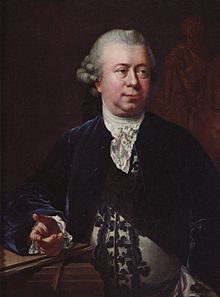Jacques Saly
| Jacques-François-Joseph Saly | |
|---|---|

Jens Juel, Portrait of Jacques Saly, oil on canvas, 1772
|
|
| Born |
20 June 1717 Valenciennes, France |
| Died | 4 May 1776 (aged 58) Valenciennes, France |
| Nationality | French |
| Education | Académie de peinture et de sculpture |
| Known for | Painting |
Jacques François Joseph Saly, also known as Jacques Saly (20 June 1717 – 4 May 1776), French-born sculptor who worked in France, Denmark, and Italy, was born in Valenciennes to François Marie Saly and his wife Marie Michelle.
He began his training as a sculptor at nine years of age under local master Antoine Gilles in Valenciennes from 1726-1727. In spite of his parents' meager income, he was sent to Paris in 1732 to train in the studio of the leading sculptor at Paris, Guillaume Coustou. At the same time he attended the school of the Académie royale de peinture et de sculpture, winning medals in 1734, 1737 and 1738.
Winning that last medal, first place in the Prix de Rome competition, gave him the right to study at the French Academy at Rome, at the time the single mainstream route to a successful official career as a sculptor in Paris. He first received his stipend in 1740, and he arrived in Rome on 13 October 1740. He stayed there for eight years between 1740–1748, and lived at the Academy. The goal here was that through the study of antiquities and the masters of the past, one would develop and refine one's artistic taste. More practically it meant making marble copies of Roman sculpture for the French king.
In 1742 he made a monumental portrait bust of Manuel Pinto de Fonseca, Grand Master of the Order of Malta. In 1744 he made a bust of a little girl which is one of the most reproduced sculptures from the 18th century.
He became one of the first French members of the Accademia degli Arcadi in Rome 1744, and of the Academy of Design at Florence, in 1748, and of the accademia di belli arti, Bologna.
He had close relations with Giovanni Battista Piranesi.
...
Wikipedia
